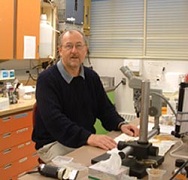

Kenneth Baimbridge
Professor Emeritus
Department Head, 1991-2003
PhD (Physiology & Biochemistry), Southampton, 1977
BSc (Physiology & Biochemistry), Southampton, 1972
Email: kenneth.baimbridge@ubc.ca
Office: 604-822-2330
Fax: 604-822-6048
Research Interests
The general theme of my research is the physiological and pathophysiological role of calcium in the central nervous system. Central to these studies are the actions of neuron specific calcium-binding proteins in the regulation of intracellular calcium ion concentration and in mediating the actions of calcium as a second messenger system. I have mostly been involved with work investigating calbindin D-28k, (formerly known as calcium-binding protein; CaBP) and paravalbumin (PV). Both proteins were originally discovered in peripheral tissues (gut and muscle, respectively), but are also found in discrete neuronal populations within the CNS. Since these proteins have not been shown to have any modulatory actions similar to calmodulin they are thought to act as intracellular calcium buffering proteins. I have attempted to apply a multi-disciplinary approach to my studies and have thus utilized biochemical, immunohistochemical, electrophysiological, molecular biological and neuroanatomical techniques.The following represents an outline of the major projects currently underway in my laboratory:
- CaBP and PV changes in animal models of epilepsy including kindling.
- CaBP and PV related to neuron death induced by ischemia.
- CaBP and its calcium buffering effects on glutamate induced calcium influx, determined by calcium imaging techniques in cultured neurons.
- Anatomical studies of neuron specific projections to the rat hippocampal formation.
- CaBP and PV localization in human brain material derived from a variety of diseases with established patterns of neuronal degeneration.
- Studies of calcium buffering mechanisms and the effect of artificial calcium buffers in cultured hippocampal neurons related to neuron death induced by excitotoxicity.
Baimbridge, K.G., Celio, M.R. and Rogers, J.H. Calcium-binding proteins in the nervous system. TINS 15:303-308, 1992.
Abdel-Hamid, K. M. and Baimbridge K.G. The effects of artificial buffers on Ca2+ responses and glutamate-mediated excitotoxicity in cultured hippocampal neurons. Neuroscience 81:673-687 1997.
Sidky, A.O. and Baimbridge K.G. Calcium homeostatic mechanisms operating in cultured post-natal rat hippocampal neurones following flash photolysis of nitro-phenyl EGTA. J. Physiol. 504:579-590 1997.
Price, C.J., Rintoul, G.L., Baimbridge, K.G., and Raymond, L.A. Inhibition of calcium-dependent NMDA receptor current rundown by calbindin D-28k. J. Neurochem. 72:634-642 1999.
Diarra, A., Sheldon, C., Brett, C.L., Baimbridge, K.G., and Church, J. Anoxia-evoked changes in intracellular pH and Ca2+ concentration changes in cultured postnatal rat hippocampal neurons. Neuroscience 93:1003-1016 1999.
Rintoul, G.L., Raymond. L.A., and Baimbridge, K.G. Calcium-buffering and protection from excitotoxic cell death by exogenous calbindin-D28k in HEK 293 cells. Cell Calcium 29:277-287 2001.
Rintoul, G.L and Baimbridge, K.G. Effects of calcium buffers and calbindin-D28k upon histamine-induced calcium oscillations and calcium waves in HeLa cells. Cell Calcium 34:131-144 2003.
Krebs, C., Fernandes, H.B., Sheldon, C., Raymond, L.A. and Baimbridge, K.G. Functional NMDA receptor subtype 2B is expressed in astrocytes following ischemia in vivo and anoxia/in vitro. J. Neuroscience 23: 3364-3372 2003.
Zeron MM, Fernandes HB, Krebs C, Shehadeh J, Wellington CL, Leavitt BR, Baimbridge KG, Hayden MR & Raymond LA. Potentiation of NMDA receptor-mediated excitotoxicity linked with intrinsic apoptotic pathway in YAC transgenic mouse model of Huntington’s disease. Mol. Cell Neurosci. 25:467-479 2004.